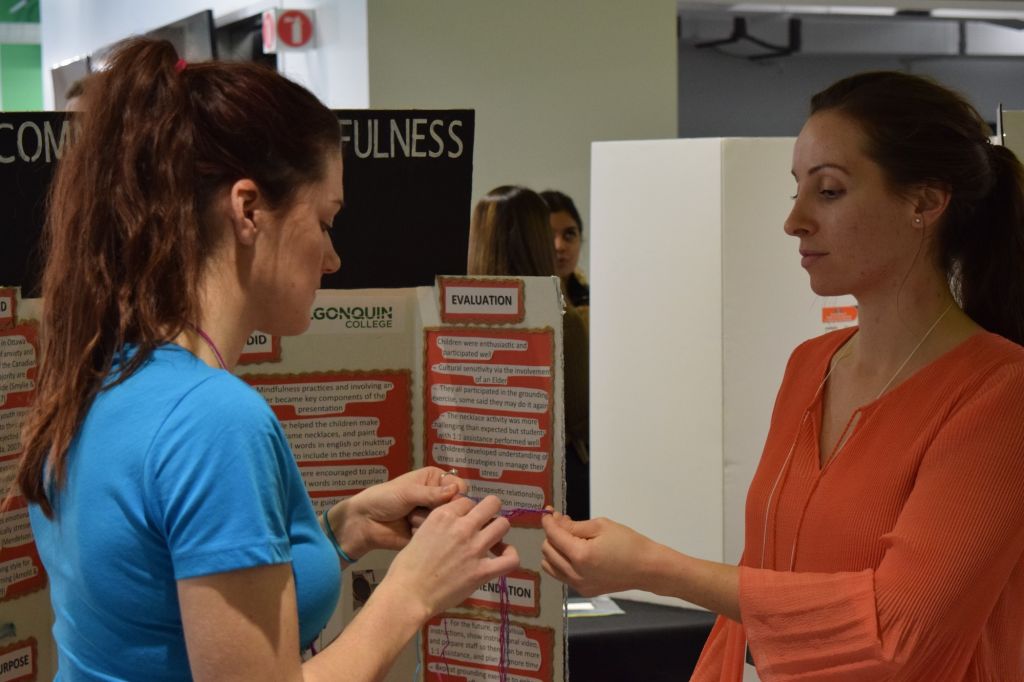Between 9:30 a.m. and 1:30 p.m. the DARE district played host to the annual RE/ACTION Applied Research Fair for Algonquin students and faculty.
The work of 240 students and 17 faculty members was displayed with 81 booths presenting 78 projects. The tables consisted of a variety of different applied research, websites, technologies and innovations.
Matthew Jerabek, one of the coordinators of Algonquin’s Applied Research and Innovation office, was in attendance as a mediator.
“The applied research showcase is highlighting student projects that have been done in partnership with industry as well as faculty,” said Jerabek. “They create new products and services, they make videos, they make websites, they engineer things. All of that is encompassed here, they bring it out in the open and it becomes research in action.”
Of the multitude of technologies that were on display, one, in particular, seemed to grab the attention of many at the fair. A tiny metallic fellow who was well ad adverse in 3D Tetris; his name is Jeffrey and he is a robot.
Curtis McCartney, a third-year computer engineering student and member of the team responsible for Jeffrey, gave a brief rundown on their creation. “This robotics project began at the start of the semester, the end goal was for Jeffrey to be able to detect, move and place objects autonomously,” said McCartney.
While the team is still in the early stages of perfecting their creation, Jeffrey will soon be performing simple tasks on his own.
Robotics set aside, there were many websites being showcased. Third-year graphic design students, Alexandra Mines and Jennifer Sommerfeld were responsible for re-developing the Peace and Conflict planner’s website. A website specifically structured to help assist in helping those affected by man-made and natural disasters around the world.
“We were given this company that helps people after natural and human-made disasters and completely rebranded their website,” said Mines. “We wanted to be able to attract different types of people, young professionals and the investors.”
The lower level of DARE was dedicated to many students who had either reached out to communities or developed their own innovations to help benefit the average person.
Bradley Talgoy, a fourth-year bachelor of science in nursing student, was adamant in informing students how common the sexually transmitted infection human papillomavirus otherwise known HPV — is in reality.
“I’m one of six students whose partnered with the Ottawa hospital mHealth labs, specifically their CANimmunize project,” said Talgoy. “We have created three different projects for the app as well as the desktop version in order to distribute health information to Canadians to allow for autonomy in healthcare.”
Their app is purpose-built to inform Canadians about vaccines available for HPV, as it is one of the most common STI’s in Canada. According to Talgoy, three in four Canadians that are sexually active will have an HPV infection in their lifetime.
“Unfortunately, infections like gonorrhoea, chlamydia and syphilis get a lot more media attention because they are little more well-known,” said Talgoy. “However, HPV is just as much of an issue because it can actually lead things like warts and the potential propagation of cancer.”
Isabel Julien, Katie Macleod-Strove and Jayme d’Entremont, all fourth-year bachelor of science in nursing, were one of the groups that reached out to a very particular community in Vanier. This community was made up of Inuit children at an afterschool daycare program.
“Mental health is a prevalent issue among the Inuit community, on the first day we had encountered the children one of them brought up the topic of suicide. Not the act of committing suicide, but the 10-year-old was aware of the topic, which was concerning,” said Julien. “The ages of the children ranged between 10 to 13. On the first day at the program when we met the children some of them were very withdrawn.”
According to Julien a few other of the children had brought up bullying. So, Julien and her colleagues decided that they wanted to focus their project on mental health. To them, stress and anxiety were an important issue to address.
“What we did was gather some keywords of anxiety and stress, causes of anxiety and stress as well as coping mechanisms,” said Julien. “We cut up some words for them out of paper that pertained to those three categories and the children would place the different words on said category. We also had an elder come in and translate the words into Inuktitut, to make it easier and more comfortable for the children.”
The fair concluded at 1:30 p.m., following the awards that were announced by President Cheryl Jensen. “This showcase is a perfect example of what DARE represents. It brings the greater Algonquin college community together around new ideas, new technologies and collaborations,” said Jensen.


